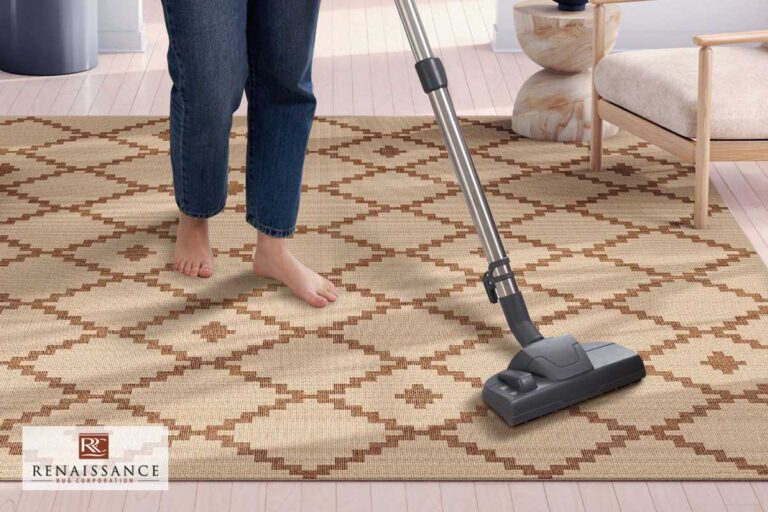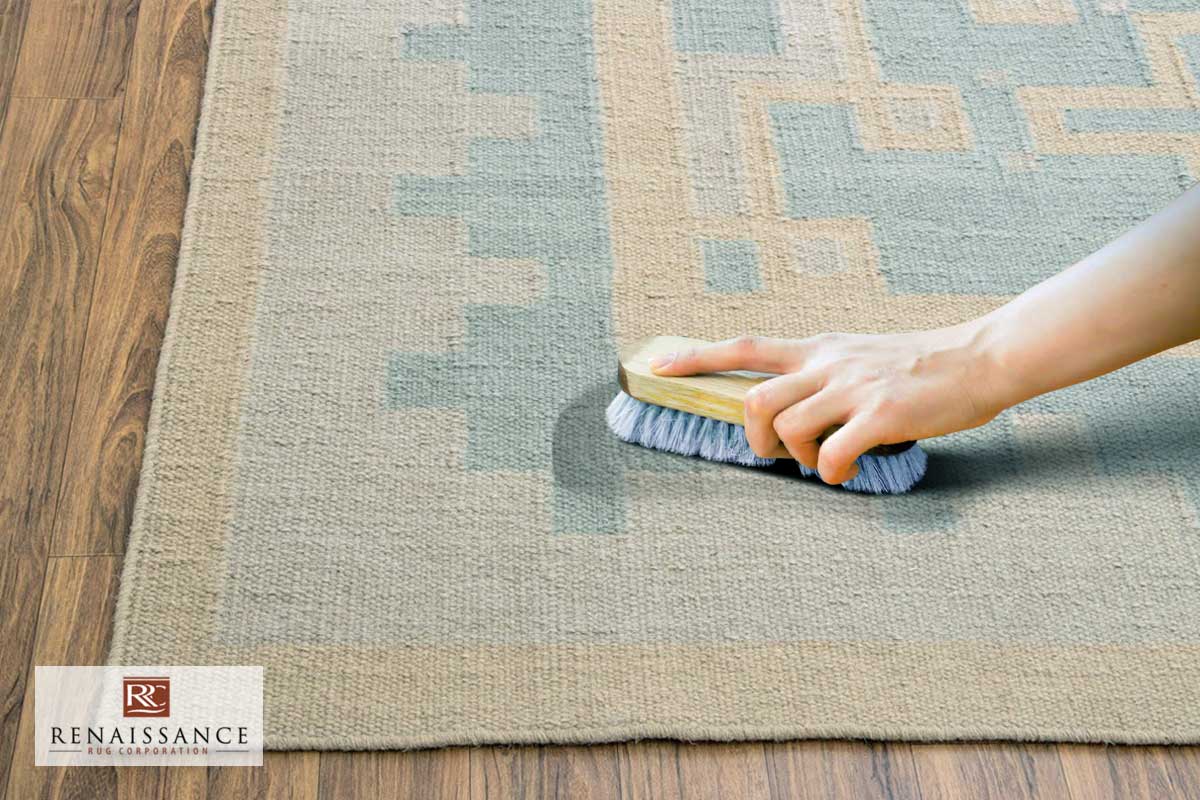Flatweave rugs are a go-to in a lot of homes. They’re lightweight, easy to move around and add nice texture and color without making the space feel heavy. But here’s the thing—they can collect dirt, dust, and spills like no one’s business. If you live with pets, kids, or just daily life, you’ll know what we mean. This guide is all about how to clean flatweave rug surfaces the right way. We’ll walk you through basic tools, everyday care, deep cleaning, drying, and simple ways to keep your rug looking good for the long haul. Whether your rug is new or has been with you for years, proper flatweave rug care makes a big difference.
Why Flatweave Rugs Require Special Care
Flatweave rugs don’t have a thick pile. That means everything—dust, crumbs, spills—sits right on the surface. That’s good in one way (easy to see), but it also means it shows everything. They also slide around easily unless you use a rug pad, and moving around causes extra wear. So, if you want to keep yours in shape, a little extra care is worth it. Flatweave rug care is all about staying ahead of the mess.
On top of that, flatweave rugs often sit in high-traffic areas like living rooms, kitchens, and hallways. These spots attract the most foot traffic, dirt, and sometimes unexpected spills. And because flatweave rugs are typically thinner than other types, they can start showing signs of wear much faster if they’re ignored. The good news is that if you clean flatweave rug surfaces regularly, you can keep them looking fresh without much effort.
Understanding the Unique Characteristics of Flatweave Rugs
Most flatweave rugs are made from cotton, wool, or synthetic blends. What makes them different is the way they’re made—they don’t have a pile. Just tight weaving. That makes them reversible and easy to move. But it also means the edges can fray or curl if you’re not careful.
Whether it’s a Hand Tufted Rug, a Hand Knotted Rug, or a Machine Made Rug, each one might need a slightly different approach. At Renaissance Rug, we always check the rug type first. It’s an important step to avoid mistakes.
Some flatweave rugs are handmade and can be delicate in certain areas. Others are machine-woven and might have more durability but less flexibility. Knowing the kind of rug you have helps you decide how to clean flatweave rug materials without doing any damage.
Essential Tools and Materials for Cleaning Flatweave Rugs
You don’t need anything fancy to clean flatweave rug surfaces. A vacuum with the brush roll turned off, a soft brush, mild soap, white vinegar, a clean cloth, and some baking soda are more than enough. Stay away from strong chemical cleaners. They can be too much for these rugs.
Having a handheld upholstery cleaner can be useful too, especially for deeper spots. Just don’t soak the rug. Too much water is a no-go for flatweaves. Keep it light, and always test a small area first if you’re unsure.
It helps to have a spray bottle filled with a water-and-vinegar mix for quick deodorizing. For stubborn odors or mystery stains, baking soda can do the trick—just sprinkle, wait, and vacuum.
Choosing the Right Vacuum and Cleaning Products
When vacuuming, don’t use the beater bar. It can damage the rug or lift it off the ground. A vacuum with strong suction but no roller is ideal. If all else fails, a handheld vacuum or even a lint roller can do the job.
Use gentle cleaners. Something simple like mild dish soap and warm water usually works. Harsh products can mess with the color and fabric. If you’re not sure, our Rug Cleaning Service in Seattle is always here to help.
We often remind people that a rug doesn’t need to look dirty to be dirty. If you clean flatweave rug fibers often, especially in homes with pets or allergies, you’re helping maintain both its look and air quality.
Step-by-Step Guide to Cleaning Your Flatweave Rug
Vacuuming and Regular Maintenance
Make vacuuming a habit. Once or twice a week is a good start. Flatweave rugs don’t hide anything, so dirt builds up fast. Flip it over and vacuum both sides if possible. Don’t forget the floor under the rug too.
A good shake outside works wonders too. And for pet hair? Lint rollers are lifesavers. Flatweave rug care is about regular attention, not just cleaning when it looks bad.
Over time, regular vacuuming helps protect the threads and keeps your rug looking new longer. If you live in a high-traffic area, you may want to up your vacuuming game. Consistency makes all the difference.
Spot Cleaning Stains and Spills
Spilled something? Blot it fast with a clean cloth. Don’t rub—that only spreads it. For most spills, mix a little dish soap with warm water. Gently dab the area, then blot it dry.
Avoid soaking the rug. Flatweaves don’t handle too much moisture well. For tough stains like wine or ink, our Rug Stain Removal Service in Seattle has your back.
If the rug is reversible, flip it and give the other side a rest while the stained part gets cleaned and dries fully. Spot cleaning is a big part of flatweave rug care and helps you catch problems before they settle in.
Deep Cleaning Your Flatweave Rug
Washing Methods and Using a Rug Cleaner
If it’s time for a deeper clean, lay the rug flat and gently scrub with a soft brush and mild soap. Work on small spots at a time. Don’t pour water on it—just use a damp cloth or sponge.
If you’re using a rug cleaner, go easy. Light setting, low moisture. Never twist or wring out the rug. If you’re not sure about doing it yourself, our Rug Cleaning Service in Seattle is always a safe bet.
For deep cleaning, once or twice a year is usually enough unless it’s in a really high-traffic area. If you clean flatweave rug materials with care, they’ll stay vibrant and comfortable underfoot for years.
Drying and Storing Your Flatweave Rug Properly
Preventing Moisture Damage and Ensuring Proper Drying
After you clean flatweave rug surfaces, drying is super important. Don’t leave it in direct sunlight too long—it can fade the colors. Lay it flat somewhere with good airflow. Flip it to dry both sides.
Don’t roll it up while it’s damp. That can cause musty smells or even mold. If you’re storing it, roll it up (don’t fold) and wrap it in breathable material. And if it’s a valuable rug, think about our Rug Appraisal Service in Seattle before you store it.
Storing it in a dry place with a rug bag helps it stay in good shape. Check it now and then to make sure no moisture or bugs have gotten in. Flatweave rug care includes knowing how to keep it safe, even when it’s not in use.
Tips for Extending the Life of Your Flatweave Rug
Avoiding Common Mistakes and Regular Care
Never drag furniture across your rug—that’s how damage starts. Rotate your rug every few months so one area doesn’t wear out faster than the rest. A rug pad helps a lot too.
Flatweave rug care works best when you don’t wait. Clean it regularly, and fix little issues early. If you see fraying or curled edges, we can help with that. Our Rug Repair Service in Seattle takes care of small problems before they turn into big ones.
It’s also a good idea to avoid eating or drinking over your rug if you can. Accidents are way easier to prevent than clean up. The more you protect it, the longer it will stay part of your space.
Conclusion
Cleaning a flatweave rug doesn’t have to be stressful. With the right approach, it’s simple. Stick to regular vacuuming, quick spot clean-ups, and light deep cleans every so often. Dry it properly and handle it gently.
If you ever need help, we’re here. At Renaissance Rug, we take pride in keeping rugs looking their best. Whether it’s stains, repairs, or full cleanings, our Services are ready when you are. Taking care of your rug isn’t just cleaning—it’s about helping it last. Clean flatweave rug routines don’t have to be hard. A little time and care go a long way.


